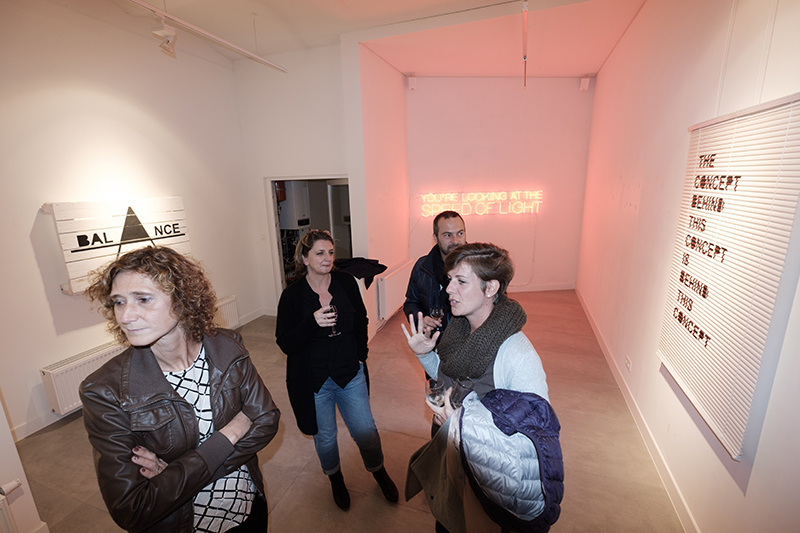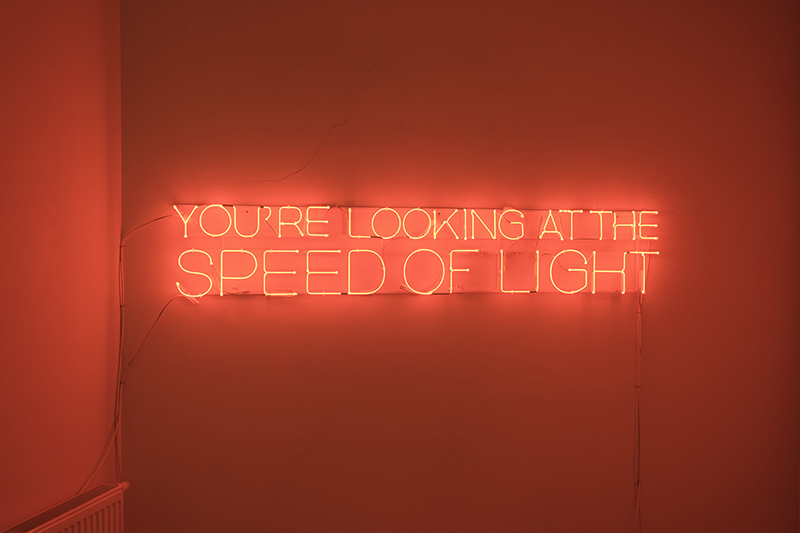Pixie Pravda likes to question the relevance of the contemporary art scene, while he strives to make a contribution to its evolution, via his own text-based, conceptual art.
I think what sets me apart from most artists is that the execution and production of my work is the least interesting part of the process for me.
Pixie Pravda

Conceptual, text-based artist Pixie Pravda.
Please tell us a little about yourself, what brought you to the world of contemporary art and how did you start?
I am a Dutch text-based conceptual artist, who lives and works in Brussels, Belgium. I value the conceptual idea as much as it’s stylistic and visual component. In my art I play with the superficiality of modern society by using slogans, symbols, logo’s, lyrics and icons from the collective memory. I like to question the relevance of the contemporary art scene and strive to make a contribution to its evolution. I am self-taught and started my practice as an artist at a later age.
As a bit of an outsider I carved out my niche, developed my own style and found recognition through my Instagram account. I have built a base of collectors who follow me and purchase my work. I sell mostly through Instagram and occasionally exhibit at solo and group shows in galleries in Belgium and abroad. I also curate and collate works of conceptual and text-based artists that I follow and admire, on Instagram.

Exhibition view. Conceptual, text-based artist Pixie Pravda.
What is the primary role of an artist? How do you describe yourself in the context of challenging people’s perspectives via your work and art?
I make art because I need to. It makes me happy, it feeds me and allows to engage in a dialogue with my followers and other artists. It helps me to express myself creatively and it’s something that is as important to me as food, love and friends. I am not on a mission or trying to change the world. I’m just trying to make my life more interesting & fun and I feel proud and fulfilled when my collectors tell me that my art enriches their lives.

Conceptual, text-based artist Pixie Pravda.
How do you deal with the conceptual difficulty and uncertainty of creating work?
As my work is idea driven, my main challenge is to come up with fresh concepts, different angles, new perspectives and original ideas all the time. And that means that I need keep to feeding the creative well by reading, thinking and questioning myself all the time, which at times can be exhausting and difficult on myself and those around me.
My work comprises communicating ideas through text in a minimalistic visual language.
What would you call your style? Let’s talk about the evolution of your practice over the years. Tell us about your commitment to your current medium.
I call it text-based conceptual art. My work comprises communicating ideas through text in a minimalistic visual language. I work in the conceptual tradition of Duchamp, Kosuth, Baldessari, Weiner, Holzer, Kruger and try to build upon that history by contributing my own take on it. I work mostly in black & white, very sober, aesthetically clean and strive to combine a strong idea with an attractive presentation. I believe I have a very recognisable and consistent voice and style.

Conceptual, text-based artist Pixie Pravda.
What inspires you? Let’s talk about your frameworks, references and process.
I am most inspired by ideas, regardless of where they come from. And it is often by looking at great work and concepts that I come up with my own. It’s all about getting in that creative zone that allows me to find the inspiration for my work. I don’t know where the ideas come from, or how the process works, and I prefer not to think about it too much, in fear of jinxing and losing it.
I have a work of art which reads: People often ask me “Pixie how do you come up with those great ideas?” And I say “I have no idea”. It’s a bit tongue in cheek but it’s absolutely 100% accurate. I have no idea how all this works and where the ideas come from, I am just happy that I have them.
Let’s talk about your career, or if you prefer artistic journey. What were your biggest learning and hiccups along the way?
I learned that I’m not in this for my ego or money. I’m doing this simply because I truly love it. Years ago, when I had my first big solo show in a well known Belgian gallery, I thought that my career was launched. But I found out that it is really hard to make a financially viable, and stable career being a conceptual artist, working in the traditional gallery system. Therefore, I decided to sell through Instagram, which allows me to build my own database of collectors and sell more works incurring less costs compared to routing transactions through a traditional gallery. I’m still interested in working with galleries though, so any gallerist or curator that reads this and thinks that we can set up a win-win-win (artist, gallery, collectors) is more than welcome to get in touch. But I won’t do it for exposure or ego, I only want to do it if it makes business sense.

Conceptual, text-based artist Pixie Pravda.
What are you looking for when you look at other artists’ work? Which shows, performances and experiences have shaped your own creative process?
There are so many artists that I love and admire but in my top ten I would definitely list Marcel Duchamp, Banksy, Joseph Kosuth, Maurizio Cattelan, Marina Abramovic, Andy Warhol, and in my specific field the Austrian artist Anatol Knotek.
I often say that my studio is my head and my brush is my computer.
Tell us about your studio, what kind of place is it? Could you describe your usual work-day in the studio?
I often say that my studio is my head and my brush is my computer. I always make my works on Photoshop and then realise them either for a show or for sale on Instagram. I can work from anywhere as long as I have a computer and inspiration, don’t need a formal studio. I think what sets me apart from most artists is that the execution and production of my work is the least interesting part of the process for me. What I enjoy most is coming up with an idea and then visualising it on my computer using Photoshop. After that it is just creating a physical copy of the digital work.

Conceptual, text-based artist Pixie Pravda.
What was your first sale? Do you handle the commercials yourself or is it outsourced to a gallery/agent?
I used to have an agent and gallery, and then I realised that nobody represents me better than I do. That said, I’m flexible in that I am always interested and open to any offers for representation and collaboration.
What are you working on now? What’s coming next season?
It’s not official yet but I’ll be announcing a big solo show soon with a well-known German gallery, that will take place in January 2021 (delayed because of Covid19).
For enquiries contact: pixiepravda [at] gmail dot com
Instagram & Text based visual artists
Before you go – you might like to browse our Artist Interviews. Interviews of artists and outliers on how to be an artist. Contemporary artists on the source of their creative inspiration.












Add Comment